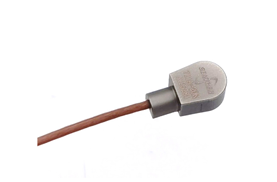In many fields such as industrial automation control, automotive, seismic measurement, military, and space systems, impact acceleration sensors play a crucial and indispensable role. So, what exactly is an impact acceleration sensor?
Micro impact acceleration sensor 712A

By definition, an impact acceleration sensor is a device that can accurately measure the acceleration of an object when it is impacted. Its working principle is based on Newton's second law, which states that force is equal to the product of mass and acceleration (F=ma). When a sensor encounters an impact, its internal mass block will generate a corresponding force due to acceleration. By accurately measuring this force, key parameters such as acceleration and velocity of the impact can be accurately calculated.
The structural forms of impact acceleration sensors are rich and diverse, with common types including column and diaphragm structures. Taking the peripheral circular support circular gauge membrane structure as an example, with a sensitive mass block in the center. At the position near the edge of the circular membrane where the strain is maximum, four resistance bars with equal resistance values are diffused along the radial 110 and tangential 110 crystal directions using the diffusion doping method. These four resistors with consistent performance are connected through a vapor deposited aluminum electrode to form a Wheatstone bridge. When subjected to an impact, the resistance value of the bridge will change, thereby outputting an electrical signal related to the impact acceleration.
The impact acceleration sensor has many significant characteristics. It is suitable for measuring and controlling impact acceleration parameters with a maximum range of 100000g, with a frequency response range of 0.1-10000Hz and an output signal range of 0.15 ± 50mv-4800mv (variable). Its measurement linearity, repeatability, and hysteresis are all better than 1%, and the power supply voltage is ± 15 ± 0.5V. In addition, it is developed using MEMS technology and microelectronics technology, integrating acceleration sensors, signal converters, power converters, signal filtering circuits, saturation control, and temperature compensation, with advantages such as micro volume, micro power consumption, micro noise, high integration, high stability, high reliability, low temperature drift, and strong environmental adaptability.
Due to these excellent characteristics, impact acceleration sensors have been widely used in various fields. In the automotive industry, it can be used for triggering and controlling airbags. When a vehicle collides, it can quickly detect the impact acceleration and trigger the airbags in a timely manner, protecting the lives of drivers and passengers; In the aerospace field, it can be used for structural health monitoring of aircraft. By monitoring the impact acceleration during flight, it can determine whether the aircraft structure has been damaged; In the military field, it can be used for performance testing of weapons and equipment, such as measuring the impact acceleration during projectile launch, missile flight, etc; In earthquake measurement, it is possible to capture the instantaneous impact acceleration of the ground during an earthquake, providing key data for earthquake research and early warning.
The impact acceleration sensor, with its unique working principle, diverse structural forms, excellent performance characteristics, and wide application fields, has become an important "eye" for sensing instantaneous impacts in modern technology, providing strong support for the development and safety of many industries.



